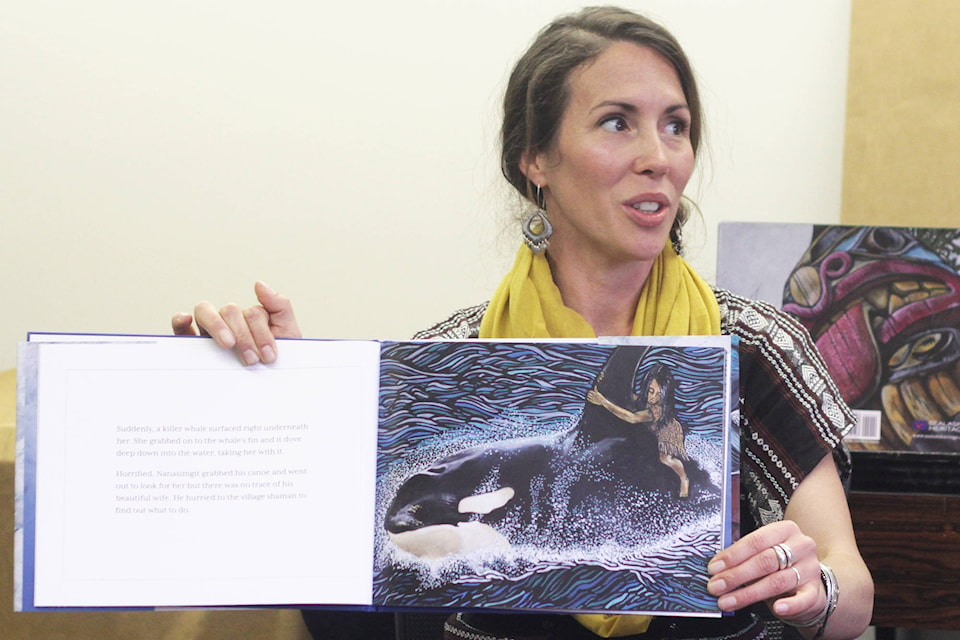Janine Gibbons grew up with stories about her bush-pilot nonni, but not her Haida heritage.
“I knew I was Haida,” Gibbons said, who grew up in Petersburg, Alaska.
“I didn’t know what that meant at all.”
But while illustrating a new children’s book, The Woman Carried Away by Killer Whales, Gibbons got a chance to fill in the picture of her own Haida heritage, and share it with the next generation.
Published by Baby Raven Reads, an award-winning literacy program of the Sealaska Heritage Institute, the book tells the Haida story of sea hunter Naa-Naa-Simgat, who rescued his wife from a supernatural killer whale at the bottom of the sea.
Gibbons also illustrated The Woman Who Married the Bear, a book in the same series that tells the Tlingit version of a story well known to Haidas as well. Both are intended for children ages five and younger.
“I wanted make sure that in each and every page there was something they could learn from,” said Gibbons, speaking at a reading in Queen Charlotte hosted by Literacy Haida Gwaii.
One of her opening illustrations shows a couple’s clasped hands, and on their hands Gibbons painted traditional tattoos. One of the book covers shows a real totem pole by Donald Varnell, and Gibbons insisted on painting it as it looked the day she saw it — half-finished, with adze marks still showing in the cedar.
To get the face-painting right in one scene from The Woman Who Married the Bear, Todd used an old photograph that a missionary took of a group of Haida women — a photo of the last time he allowed them to do put on their traditional face painting and regalia.
“Every time I see that picture, it makes me feel,” Gibbons said. “It’s like, ‘Say cheese! We’re taking everything away.’”
Still another scene shows kids tucked in bed after listening to a story, and sharp-eyed readers will notice that their pillow cases are decorated with the leaves of plants actually found in Haida Gwaii forests.
And Haida Gwaii readers might just recognize one of the orcas painted in The Woman Carried Away by Killer Whales, which Gibbons based on a photo that a friend took of one breaching in Skidegate Inlet. Fans of the Skidegate Saints might even recognize a few faces around the fire when Naa-Naa-Simgat travels to the undersea Killer Whale House — Gibbons modelled the characters on a shot of the men’s basketball team.
Of the dozens of images that Gibbons drew from Haida Gwaii, from visits to the Vancouver Museum of Anthropology, the Burke Museum in Seattle, or the kelp bed just outside her house in Petersburg, one at the close of The Woman Who Married the Bear shows a dying bear slipping into the woods, nearly unseen among the trees.
Gibbons painted it as an homage to her Haida grandmother, Helen Todd, who was just 40 when she died after her bush plane crashed on a glassy lake in the middle of Annette Island (The nearby Tlingit community named the lake in her honour).
Just before the crash, Todd wrote in a letter about a dream she had, of following her father as he slipped into a cedar forest.
While the story of Naa-Naa-Simgat may be new to her, Gibbons did grow up with the legend of her grandmother — a woman who got Ketchikan’s “biggest buck” hunting contest cancelled after winning it so many years in a row. Not only was she a pilot in the 1950s, when female pilots were a rare thing, she would fly away for weeks at a time, checking her remote traplines for beaver, wolf and marten.
That convention-bucking attitude seems to be alive and well in Gibbons’ approach to art.
“My mom did not want me to become an artist — she wanted me to drive heavy equipment,” she said.
Best known as a jewelry designer, Gibbons uses a unique enamelling technique that she taught herself.
And Gibbons was not shy to follow her instincts while doing her first book illustrations.
Rather than follow a suggestion to paint the unusual couple of The Woman Who Married the Bear together in a kitchen, Gibbons showed their feet and paws curled up in bed.
“This isn’t Berenstain Bears,” she said, laughing.
Likewise, toward the end of the book, Gibbons insisted on a picture with plenty of big, beautiful flowers.
“Wait a minute, if this is a story about women, I’m painting flowers,” she said. “We like flowers now, we liked flowers 10,000 years ago. We still like flowers.”
Copies of The Woman Who Married the Bear and The Woman Carried Away by Killer Whales are on order at the Haida Heritage Centre, and are also available through the website of the Sealaska Heritage Institute. Gibbons’ original paintings for both books will be on display in Juneau, Alaska during the next Celebration event, set for June 6 to 9.
